From the Railroad Era to the inverted pyramid, St. Pete's piers took on many forms since the 1800s
The Railroad Pier (Courtesy: St. Petersburg Museum of History) was the first official pier in St. Pete. The new St. Pete Pier (right) is the eighth major pier in the city's history.
ST. PETERSBURG, Fla. - Landmarks are a source of pride for locals and a destination for others. Like the Space Needle in Seattle or the Gateway Arch of St. Louis, the Pier is a visual representation of St. Petersburg's identity and its history.
The scenic waterfront view of Tampa Bay caught the eye of its earliest settlers -- not just for its beauty, but for its ideal location to trade goods. To date, the city recognizes eight piers throughout its years, with the first one opening in 1889, before St. Pete was even incorporated as a city.
The newest pier, which officially opened July 6, looks nothing like its inverted-pyramid predecessor. It is the eighth major pier in the city’s history.
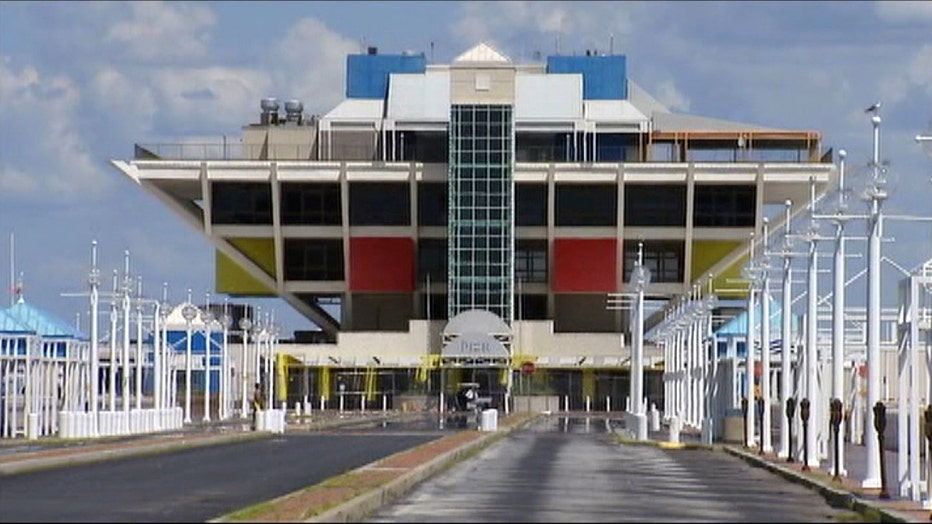
The famous inverted pyramid was demolished in 2015. (FOX 13 / file)
The first pier head that jetted out into Tampa Bay back in the 1800s set the stage for the popular downtown we have today. The structure has become a prime spot for both visitors and residents to enjoy.
PHOTO GALLERY: St. Pete's piers through the years
Interestingly enough, before the turn of the 20th century, the first pier structure that stretched out into the bay was not designed with fun in mind -- but that quickly changed.

Aerial view from SkyFOX showing the new St. Pete Pier days before it prepared to open on July 6, 2020. (FOX 13 News)
City of St. Petersburg – and The Railroad Pier – takes shape (1889-1952)
The U.S. Navy was the first to set their sights on the undeveloped land that would become St. Petersburg much, much later.
Lt. C.H. Berryman, a U.S. Navy surveyor, measured the depth of Tampa Bay off the coast, and discovered the area would be a prime spot for a railroad depot and a deep-water port for cargo ships.

A photo from 1904 of the Railroad Pier and its bathing pavilion. (St. Petersburg Museum of History)
Eventually, the Navy chose to abandon their plans, but Berryman measured over 30,000 soundings of the waters of Tampa Bay.
The findings inspired a railroad mogul, Peter Demens, a Russian aristocrat who left his native country for America.
Demens settled in Longwood, Florida and wanted to find land -- in what we know as Pinellas County -- to extend the Orange Belt Railway, build a hotel for passengers, and design a pier that would allow people and goods to arrive by train and leave by ship, and vice versa.

Engine No. 7 was part of the Orange Belt Railroad. It traveled to St. Pete as early as 1890 with passengers who were also Detroit Hotel guests. (St. Petersburg Museum of History)
That’s when he met General John C. Williams, a Detroit native, who owned 2,500 acres of land in what is now downtown St. Petersburg. Both struck a deal and Demens brought the Orange Belt Railway to the Pinellas coast.
The Railroad Pier was finished in 1889. The 2,000-foot pier extended nearly half a mile into Tampa Bay and reached 12 feet deep. The Detroit Hotel, named after Williams’ hometown, was also constructed for passengers.
The area’s fishing economy boomed when Henry Hibbs opened a fish house, called the “Henry Hibbs Fish & Oyster Company,” the same year the pier opened. It employed nearly 300 people from Clearwater to Sarasota Bay.
The Crystal Ice Manufacturing Company was also established allowing for fresh fish to be shipped. William L. Straub, the owner of the St. Petersburg Times at the time, reported packing crews offloaded 125,000 pounds of mackerel within 36 hours.
Demens named the area after his birthplace: St. Petersburg, Russia, and the city became incorporated in June 1903.
While the Railroad Pier was built for trade and commerce, the beautiful waterfront view began attracting tourists and those who fished for fun. The “No Fishing” signs at the pier were ignored, and the rule was rarely enforced.

Photo of people fishing from the Railroad Pier in 1897 (St. Petersburg Museum of History)
A bathing pavilion eventually opened and swimmers were diving into the bay. One bath cost 25 cents, or $1 for five baths. People arrived by sailboat, on foot and by a mule-drawn railcar.

The bathing pavilion at Peter Demen's Railroad Pier (St. Petersburg Museum of History)
In 1921, a hurricane damaged the Railroad Pier, killing seven of Hibbs' men.

The Railroad Pier suffered damage following the 1921 hurricane (St. Petersburg Museum of History)
By 1952, times were changing and so did the ownership. The Railroad Pier was torn down.
The Brantley Pier (1896-1904)
In 1895, Henry Plant purchased the Orange Belt Railway, and the Railroad Pier along with it.
Nearby, a local boat builder, D.F.S. Brantley, decided to build an entirely new pier: The Brantley Pier.

Photo of Brantley Pier with its bathing pavilion, which rivaled the one at the Railroad Pier (St. Petersburg Museum of History)
It was the first pier that jutted from present-day 2nd Avenue NE -- about three blocks away from the Railroad Pier -- starting the tradition of piers at the dead-end of that street.
Brantely Pier had a 34-room bathing pavilion, making it the favored place for the younger generations. People were excited to see a horse-drawn flatcar used to shuttle goods and people.
As St. Pete became a destination for fun, the Brantley Pier was demolished in 1904, making way for more recreation-focused piers.
The Fountain of Youth Pier (1901-1921)
This Pier idea was more unusual than the rest.
Edwin H. Tomlinson built the 2,000-foot Fountain of Youth Pier near the east end of present-day 3rd Avenue South. Soon after the pier was built, a man named Dr. Jesse F. Conrad purchased the pier and raised an arch bearing the name “Fountain of Youth Pier.”

Photo of the Fountain of Youth Pier, the city's "first tourist trap" (St. Petersburg Museum of History)
Conrad hired a man named J.E. Newhouse to manage a bathhouse with a “mineral bath mystique." Both operated one in Ohio since 1880, which attracted about 10,000 visitors every summer.
The well’s water, apparently, could restore visitors’ bodies and souls. At least, that’s how it was promoted. It became a popular stop where people would fill up their jugs with the water, which, in reality, had high amounts of lithium.
The Fountain of Youth Pier was considered to be “St. Petersburg’s first tourist trap.”

(St. Petersburg Museum of History)
Conrad and Newhouse hoped for the same success in Florida, but medical advances after World War II led to a decline in popularity.
The Fountain of Youth Pier was destroyed by the 1921 hurricane. The well was moved to 4th Avenue and 1st Street South during the construction of Al Lang Field.
Today, it’s connected to the city's ordinary tap water.
The Electric Pier (1905-1913)
This replaced the Brantley Pier after it was demolished in 1904.
A man named Frank Davis was the ideal person to design the Electric Pier. He owned the St. Petersburg Electric Light & Power Company and the St. Petersburg & Gulf Electric Railway.

People were often in line to jump onto the Electric Pier's trolley, which took them to the end of the pier, where they wait for an excursion boat. (St. Petersburg Museum of History)
Once completed, St. Petersburg had more than eight miles worth of the trolley track. The 3,000-foot Electric Pier became a tourist attraction, and known for its hundreds of electric lights and streetcar lines.
The trolley operator, Ken Johnson, worked in his position for over 30 years. He once tried to quit, but Davis offered him a raise and a more comfortable operator’s seat.
Trolley riders would typically be seen at the Electric Pier with luggage, waiting for an excursion boat to take them to Tampa, Pass-a-Grille, Egmont Key and Clearwater. Later, longer travels to places like Key West and Cuba were added to the schedule.

Trolley on the Electric Pier (St. Petersburg Museum of History)
Round trips between St. Petersburg and Tampa cost as little as 50 cents, and special $2 dinner cruises were also offered. “Margaret” was the name of one of the more popular passenger vessels.
During this period, the waterfront was described as “trashy.” Damp fishnets, makeshift repair yards, fishing skiffs and debris lined the area.
The Municipal Recreation Pier (1913-1921)
This 2,000-foot long wooden structure sat at the end of the Second Avenue North, and next to the site of the previous Electric Pier. It officially opened in December 1913, and is the first pier to accommodate vehicles.
The pier approach included a hangar, an aquarium, a dance hall, banquet facility and indoor swimming pool called the “Spa.” The building held three pools, baths, playground equipment and a beach access. It was a hit with pier visitors.
A sandwich shop, tennis courts, a solarium for nude tanning, and a senior citizen’s center was later added.
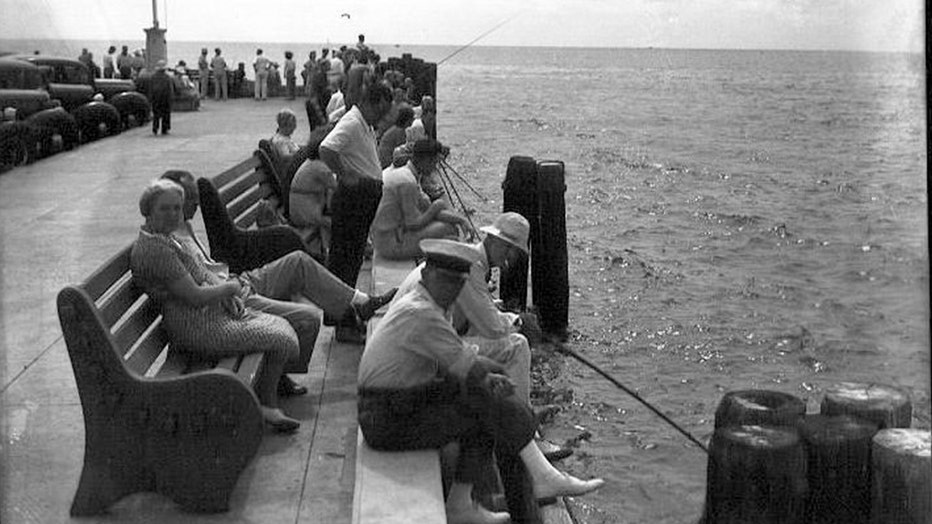
A favorite pastime: People fishing off the Municipal Recreation Pier. (St. Petersburg Museum of History)
The Municipal Recreation Pier was the first sign of what would be an economic boom for St. Petersburg.
On January 1, 1914, Tony Jannus flew the first scheduled commercial airline flight from St. Pete to Tampa, and onlookers watched the historical moment from the pier. The entire trip was 22 minutes, whereas other modes of transportation across Tampa Bay took hours.
Then, that spring, Albert Fielding Lang tried to attract a baseball team to the city.
He was turned down by the Pittsburgh Pirates, but convinced the St. Louis Browns to come to the city. The first game against the Chicago Cubs took place in Coffee Pot Park.

Photo of the Municipal Recreation Pier. (St. Petersburg Museum of History)
On October 25, 1921, nearly every pier in St. Petersburg was destroyed by a hurricane, including the Recreation Pier. The spa bathing pavilion was a complete loss.
In a matter of weeks, leaders wanted to push for a grander replacement for all of the public to use.
The Million Dollar Pier and Casino (1926-1967)
This pier didn’t exactly cost a million dollars. In fact, its construction came under budget at $998,729.18, but the rounded-up number sounded better for marketing purposes.
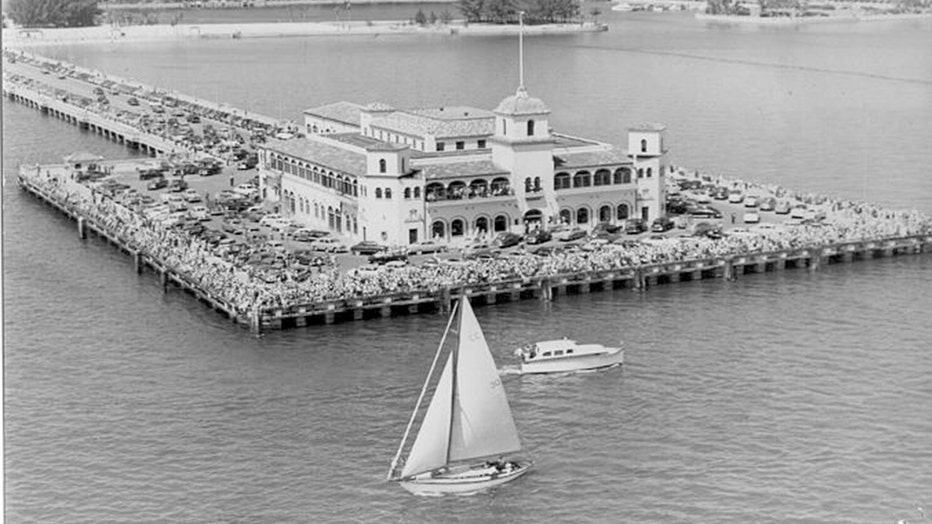
Photo of the Million Dollar Pier (St. Petersburg Museum of History)
There were about 10,000 in attendance when it opened on Thanksgiving Day in 1926. Spectators were even on the rooftop for a better view, damaging the clay roof tiles. “No trespassing” signs were placed on the roof after that.
At the center of the Million Dollar Pier was an open-air ballroom that was packed on opening day. It also had its own solarium, Spa Beach and bait houses.
Even during the warm summers, the pier had many visitors. In the 1929 tourist season alone, an estimated 7,000 cars drove to the pier. Between July 1928 and January 1929, there were visitors from every state, and people from England, Canada and other countries.

The ballroom of the Million Dollar Pier was an open-air concept. It was packed on opening day. (St. Petersburg Museum of History)
In 1927, WSUN radio began broadcasting three nights a week from its $40,000 studio. The city’s Chamber of Commerce and Clearwater Chamber of Commerce owned and operated the facility. It allowed them to broadcast local programs. WSUN reportedly stood for “Why Stay Up North?”
Along the north and south sides of the Million Dollar Pier, the Coast Guard docked its ships. On the western side, privately-owned yachts were docked.
The Million Dollar Pier was the hotspot for visitors and residents. It was the starting point for the St. Petersburg-to-Havana yacht race. It hosted events for dozens of state and national associations. One promoter traveled the country with an alligator named, “Trouble,” encouraging people to visit St. Petersburg.

People are seen enjoying the perks of Tampa Bay, with the Million Dollar Pier in the backdrop (St. Petersburg Museum of History)
Local tourism died down during WWII, but the pier was a favorite spot for service members. Most lounging facilities were used to house soldiers, sailors, pilots, wives, trainees and other personnel.
Many military members, who trained in St. Petersburg, eventually returned as either residents or visitors after the war. The city eventually returned to its “resort-community status.”

During wartime, nearly 25,000 men trained in St. Petersburg to serve in the U.S. Merchant Marines. Here they are practicing in whaleboats near the Million Dollar Pier. (St. Petersburg Museum of History)
By the 1960s, social justice and civil rights came to the forefront in America. Around the same time, there were attempts to bring a younger population to the city, which included getting rid of the famous green benches. It was an “effort to eliminate the visible presence of retirees.”

Water skiing was a popular activity at the pier. Exhibitions at the yacht basin were often scheduled to draw younger crowds. (St. Petersburg Museum of History)
Unfortunately, to the disappointment of many, the Million Dollar Pier was also a target as St. Petersburg began seeing less people in its clubhouses and more vacant hotel rooms. After 40 years, the writing was on the wall as the pier fell into disrepair in the 1960s.
The Million Dollar Pier was demolished in July 1967.

The Million Dollar Pier during its demolition (St. Petersburg Museum of History)
The Inverted Pyramid (1973-2013)
After the Million Dollar Pier was cleared, the space at the pier head was empty, filled with picnic shelters, benches and tables.

An empty pier head after the Million Dollar Pier was demolished, making way for the inverted pyramid. (St. Petersburg Museum of History)
Eventually, city council members voted for a new pier to be constructed for the 1970-1971 tourist season. They didn’t want it to cost more than $2 million. They wanted a completely new look, and selected the inverted pyramid design by architect William Harvard Sr.
Of course, things don’t always go as planned. The construction cost was $2 million over budget and didn’t officially open until January 1973.

A file image of the old St. Pete Pier (FOX 13 / file)
The Pier remains a close memory – one that locals and visitors still reminisce. It had shops and restaurants, including Cha Cha Coconuts, located on the rooftop, offering picturesque waterfront views of the bay.
During this time, the Pier was plagued with problems. The cost to operate the pier grew expensive. Between lawsuits, leaky roofs, changes in management and saltwater erosion, the city was forced to close the Pier in 1986 for $12-million worth of renovations.
When it reopened on August 12, 1988, its upgrades included an expanded first floor with more shops to choose from, a boat dock, glass elevator and an aquarium. Alessi Bakery was added to the first floor. Cesar Gonzmart opened a banquet hall on the third floor and his family’s Columbia restaurant was added to the fourth floor.

The glass elevator at the old St. Pete Pier (St. Petersburg Museum of History)
City leaders were hopeful the updates would attract people again. They hoped for up to two million in the first year, and were happy to report over 500,000 guests visited the Pier in the first month.
Sadly, there were more structural issues within a year. Decay and leaks were discovered in the pier approach.

An aerial view of the previous St. Pete Pier, the inverted pyramid. (St. Petersburg Museum of History)
Due to the elevator, air-conditioning, heating and trolley issues, the city forecasted an annual operations deficit of $1.2 million. In 2004, more investigations revealed that the pier head, originally built in the 1920s, was deteriorating. It had to be replaced within 10 years, which could cost anywhere between $25 million to $40 million.
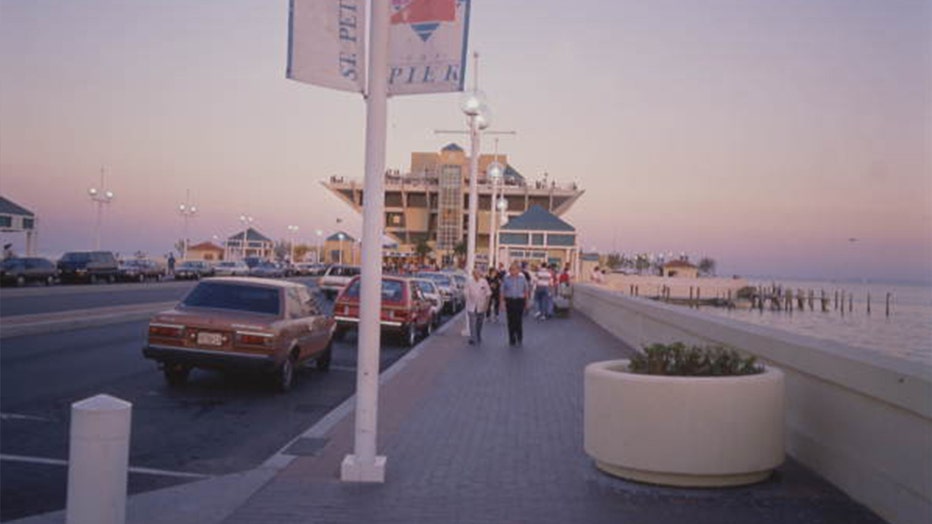
A 1989 photo showing the pier approach to the old St. Pete Pier (Robert M. Overton, Florida Department of Commerce)
In 2009, the St. Pete council members decided it was time to move on from the inverted pyramid, and a task force was created.
Before the inverted pyramid was demolished, city leaders wanted to find a replacement and started accepting submissions. In January 2012, a committee chose a controversial design, “The Lens,” created by Michael Maltzam Architecture. It would have cost $50 million.
A campaign began to prevent The Lens from being built, which led to a referendum. One major issue was The Lens called for a visible reef garden. However, it was deemed unrealistic in Tampa Bay’s darker waters.
Ultimately, St. Petersburg voters shot down the “Lens” design in August 2013. The St. Pete Pier officially closed to the public in the same year, and the next step was unknown.
The St. Pete Pier (2020)
In January 2014, the selection process for the Pier’s replacement started over. This time, a public online survey allowed St. Pete residents to provide their input.
After several meetings with the pier committee, the “Pier Park” design was chosen, but the city is sticking to the name “St. Pete Pier,” officially for the new landmark.
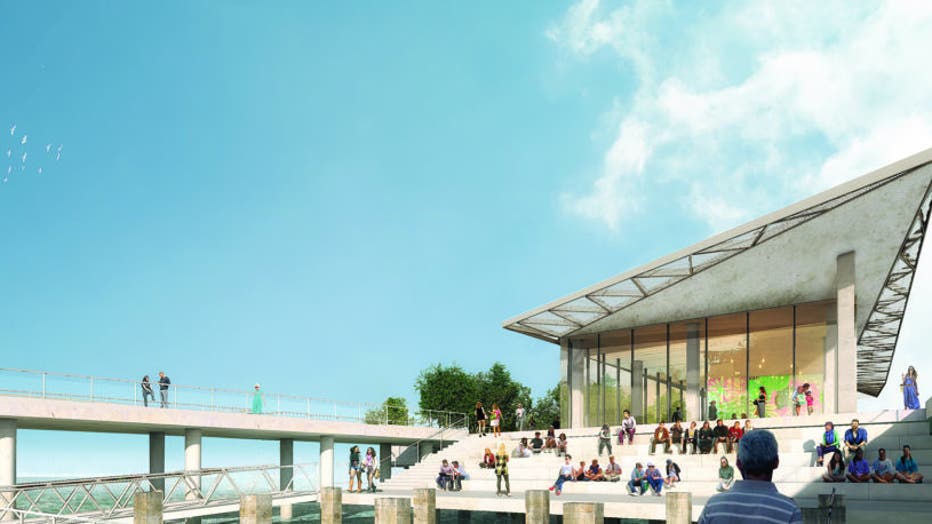
After delays due to construction and the pandemic, the new St. Pete Pier opens July 6, 2020. (Rendering provided by City of St. Petersburg)
In July 2015, city council members approved a $5.2 million deal to demolish the inverted pyramid version and finalize plans for the new pier.
The demolition of the nostalgic inverted pyramid began in August 2015, and was completed in November.
Timelapse shows demolition of old St. Pete Pier
The former St. Pete Pier, the inverted pyramid, was demolished back in 2015, making way for its replacement, which opens July 6.
PREVIOUS: St. Pete Pier comes down piece by piece
The site at the end of 2nd Avenue NE was closed off for over a decade – allowing access to only construction workers and the occasional flock of brown pelicans, St. Peterburg’s official bird.
The new St. Pete Pier’s groundbreaking was held in 2017. It features restaurants, like Doc Ford's Rum Bar & Grille and Pier Teaki, a rooftop top.

Doc Ford's is one of the restaurants located at the Pier (City of St. Petersburg)
There's a splash pad, biking is allowed, and people can once again take a dip in Tampa Bay -- just like in years past, plus 360-degree panoramic views of Tampa Bay and the St. Petersburg skyline.
There will be a fishing desk (this time, fishing is allowed -- unlike those Railroad Pier days) and a shaded waterfront area to take in the sunsets.
Art has become part of downtown St. Pete's culture. Knowing this, city officials hired three artists to provide public art for the area surrounding the Pier.

The Spa Beach at the new St. Pete Pier (City of St. Petersburg)
The opening of the pier was pushed back due to construction delays. A grand opening date was set for May 30, but the world quickly changed. Once again, its opening was delayed due to the pandemic as city officials wanted to avoid a mass gathering situation.

An aerial view from SkyFOX of the new St. Pete Pier District (FOX 13 News)
On a steamy summer day, with some safety protocols in place, the new St. Pete Pier finally opened July 6, allowing for new memories in a timeless area of the Sunshine City.
The historical information in this article was provided by the St. Petersburg Museum of History, the City of St. Petersburg, and Pinellas County Government.

